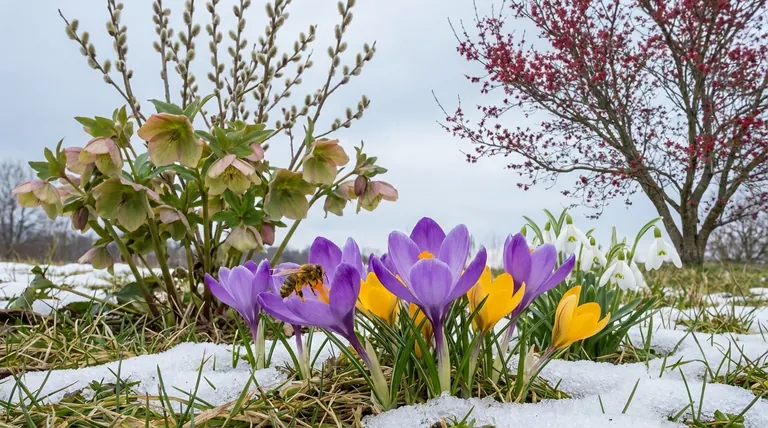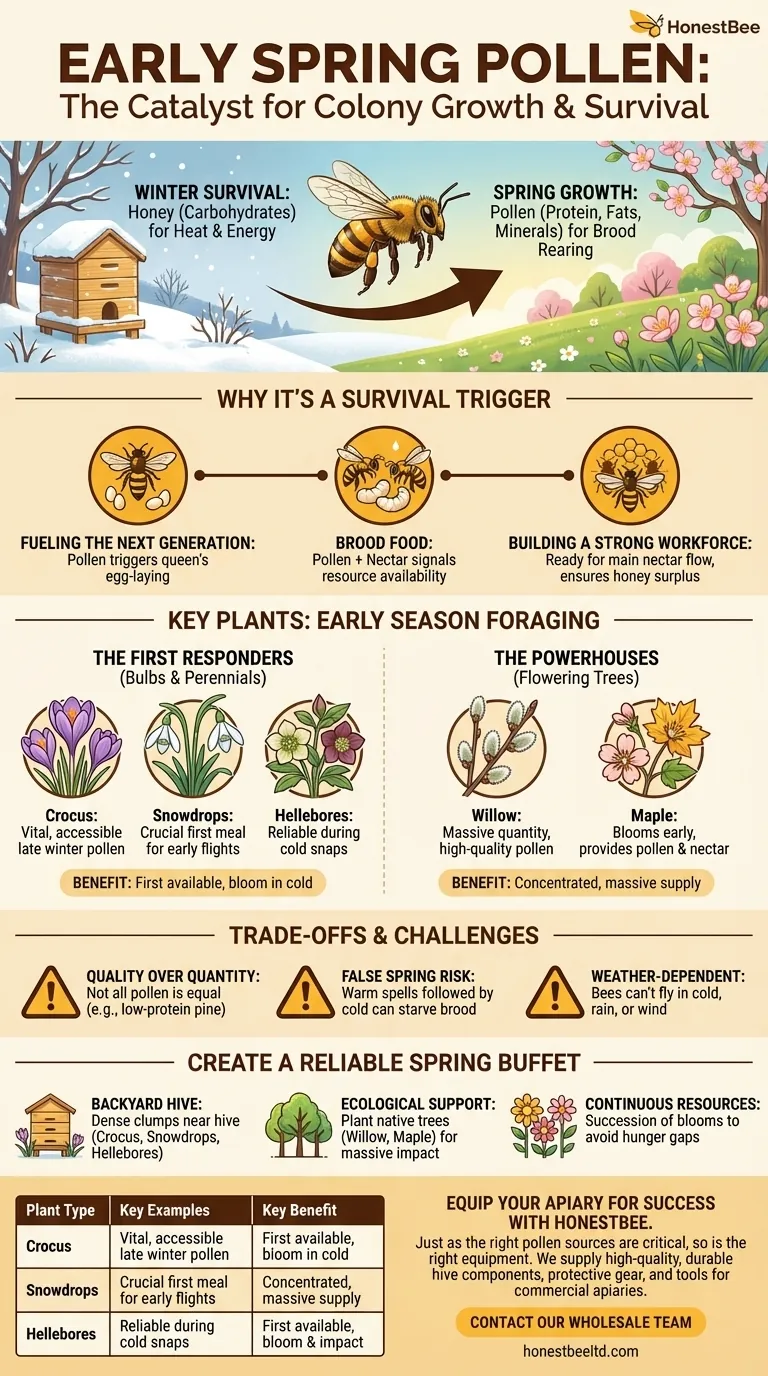In early Spring, honeybees rely on a critical, select group of blooming plants for their survival. Key natural sources of pollen include flowering bulbs like snowdrops and crocus, hardy perennials like hellebores, and powerhouse trees such as willows. These early bloomers provide the essential protein required to restart brood production and rebuild the colony after the long winter.
The central challenge for a honeybee colony emerging from winter is not just finding food, but finding high-protein pollen at the precise moment the queen begins laying eggs. This first pollen is the trigger and fuel for raising the next generation of bees.

Why Early Spring Pollen is a Survival Trigger
A honeybee colony's ability to thrive through the season is determined in the first few weeks of spring. The availability of pollen is the most critical factor in this equation.
The Shift from Survival to Growth
Throughout winter, the colony subsists on stored honey, which is a carbohydrate used for heat and energy. By late winter, their protein reserves are completely depleted. Pollen is the sole natural source of the proteins, fats, and minerals essential for growth.
Fueling the Next Generation
The queen bee's egg-laying is directly tied to the influx of fresh pollen. When worker bees return with pollen, it signals that resources are available to feed new larvae. This "brood food," a mixture of pollen and nectar, is what allows the colony to begin raising thousands of new bees.
Building a Strong Workforce
A strong early pollen flow allows the colony to rapidly build its population. This ensures there are enough foragers ready for the main nectar flow later in spring (e.g., from dandelions, fruit trees, and clover), which is what produces the honey surplus. A weak start almost guarantees a weak honey harvest.
Key Plants for Early Season Foraging
While many plants provide pollen, only a few bloom reliably in the cold, unpredictable weather of early spring. These can be grouped by their scale and impact.
The First Responders: Bulbs and Perennials
These are often the very first blooms bees will find, sometimes pushing through snow.
- Crocus: These provide a vital, accessible source of pollen in late winter and early spring. Planting them in large, dense drifts makes them a highly efficient food source for foragers.
- Snowdrops (Galanthus): As one of the earliest flowers to emerge, snowdrops are a crucial first meal for bees taking their first flights of the year.
- Hellebores (Lenten Rose): Hellebores are exceptionally valuable because they produce nectar and pollen during cold snaps when little else is blooming, offering a reliable resource.
The Powerhouses: Flowering Trees
While small flowers are important, flowering trees offer a massive, concentrated supply of pollen that can feed an entire apiary.
- Willow (Salix species): Willow is arguably one of the most important early spring pollen sources. Its catkins produce an enormous quantity of high-quality, protein-rich pollen that fuels explosive colony growth.
- Maple (Acer species): Red and silver maples bloom very early, often before willows. Their flowers provide both pollen and nectar, giving colonies a significant boost.
Understanding the Trade-offs and Challenges
Providing for bees in early spring is more complex than simply having flowers. The context of weather and food quality is crucial.
Quality Over Quantity
Not all pollen is nutritionally equal. Bees may be forced to collect low-protein pollen from wind-pollinated trees like pine if nothing else is available. While this can sustain them temporarily, it does not support robust brood-rearing like the pollen from willows or maples.
The Risk of a "False Spring"
Warm spells can encourage the queen to start laying eggs, increasing the colony's demand for protein. If a cold snap returns and prevents bees from foraging on the available blooms, the developing brood can starve. This makes the presence of cold-hardy flowers like hellebores especially important.
Foraging is Weather-Dependent
Bees cannot fly in cold, rainy, or overly windy conditions. Even if a landscape is filled with ideal flowers, a week of bad weather can confine the bees to the hive, halting the collection of vital resources. This is why a diversity of plants that bloom at slightly different times is so essential.
How to Create a Reliable Spring Buffet for Bees
Your planting strategy can directly impact the health and success of local bee populations. Tailor your choices to your specific goals.
- If your primary focus is supporting a backyard hive: Plant large, dense clumps of crocus, snowdrops, and hellebores within 100 feet of the hive for easy, low-energy foraging on the first warm days.
- If your primary focus is broad ecological support: Plant native willow and maple trees. A single flowering tree provides more nutritional resources than hundreds of smaller flowers combined.
- If your primary focus is ensuring continuous resources: Design a succession of blooms. Start with snowdrops and hellebores, followed by crocus and maples, and lead into willows and dandelions to ensure there are no hunger gaps.
By understanding what bees need in early spring, you can transform your landscape into a powerful engine for pollinator survival and growth.
Summary Table:
| Plant Type | Key Examples | Key Benefit for Bees |
|---|---|---|
| Bulbs & Perennials | Crocus, Snowdrops, Hellebores | First available food, bloom in cold weather |
| Flowering Trees | Willow, Maple | Massive, high-protein pollen source |
Equip Your Apiary for a Successful Season with HONESTBEE
Just as the right pollen sources are critical for early spring bee survival, the right equipment is essential for your beekeeping operation's success. At HONESTBEE, we supply commercial apiaries and beekeeping equipment distributors with the high-quality, durable supplies needed to manage strong, productive colonies—from hive components to protective gear and harvesting tools.
Ready to build a stronger, more productive operation? Contact our wholesale team today to discuss your equipment needs and how we can support your growth.
Visual Guide

Related Products
- Professional Wide Blade Honey Scraper for Beekeeping and Honey Processing
- Professional Long-Handled Silicone Honey Scraper for Beekeeping
- Professional Galvanized Hive Strap with Secure Locking Buckle for Beekeeping
- Stainless Steel Honey Press Wax Press with Tank
- Retractable Chinese Queen Rearing Grafting Tools Equipment
People Also Ask
- Can I extract uncapped honey? Avoid spoilage by trusting the bees' quality control.
- Why is my honey frame not capped? Your Guide to Perfectly Ripe Honey
- How can a capping scratcher be used with an electric knife? Boost Efficiency and Honey Yield
- What tools are available for uncapping honey? A Guide to Choosing the Right Tool for Your Operation
- What equipment do you need to make honey? A Complete Guide to Starting Your Apiary



















